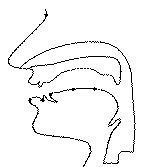






Speech Production
 Anatomy
Anatomy
The vocal tract may be viewed as a set of
resonating cavities bounded by anatomical
structures which are either fixed or movable.
 Acoustics
Acoustics
Sound is generated in several ways and at several
locations in the human vocal tract. The most common sound generation
sources are the quasi-periodic vibration of the
vocal cords and
turbulent noise generated by the passage of air through a narrow
constriction, usually in the oral cavity. More rarely, sounds are
generated by plosive release of air (following the buildup of pressure
behind an obstruction in the vocal tract), implosion (following the
creation of a vacuum behind an obstruction in the vocal tract), and
clicks created by, the action of the tongue pulling away from the roof
of the mouth.Wherever generated, the sounds underlying speech are relatively unstructured. For instance, the buzz-like sound of vocal cord vibration has a relatively simple spectral properties with harmonics at frequencies corresponding to integer multiples of the fundamental frequency. Similarly, friction noise generated by turbulence has a relatively broad frequency distribution with a somewhat high pass characteristic.
Despite the simple characteristics of the sound sources used in speech, the speech signal itself is complexly structured in both frequency and time. This structure derives from the response characteristics of the vocal tract with resonances (poles) and anti-resonances (zeroes) located at frequencies determined by a variety of factors, but primarily the length and cross-sectional area of the vocal tract above the location of the sound source. The signal is further structured in time by the motions of articulators which constantly effects changes in the vocal tract response characteristics.